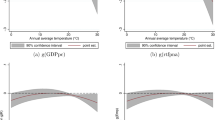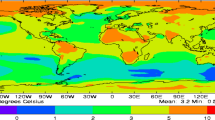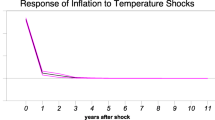Abstract
Recently it has been hypothesized that climate change will affect total factor productivity growth. Given the importance of TFP for long-run economic growth, if true this would entail a substantial upward revision of current impact estimates. Using macro TFP data from a recently developed dataset in the Penn World Table, we test this hypothesis by directly examining the nature of the relationship between annual temperature shocks and TFP growth rates in the period 1960–2006. The results show a negative relationship only exists in poor countries, where a 1 °C annual increase in temperature decreases TFP growth rates by about 1.1–1.8 percentage points, whereas the impact is indistinguishable from zero in rich countries. Extrapolating from weather to climate, the possibility of dynamic effects of climate change in poor countries increases concerns over the distributional issues of future impacts and, from a policy perspective, restates the case for complementarity between climate policy and poverty reduction.




Similar content being viewed by others
Notes
As they explain: “panel data exploit the exogeneity of cross-time weather variation, allowing for causative identification”.
Note that this series has only recently become available. Previous studies of the impact of climate change on economic growth, reviewed above, therefore did not have access to these data.
For the panel unit root tests for annual TFP growth, temperature change and precipitation change, see Web Appendix (2), Tables A.1–A.6.
The choice of the countries has been made on the basis of data availability. For the list of countries, see Web Appendix (4).
For the appropriateness of the FE approach compared to a random effects (RE) specification, see Web Appendix (2), Table A.7.
For the list of regions, see Web Appendix (5).
See, e.g., Colmer (2017) on the link between weather changes and labour reallocation across sectors.
The cut-off point for GDP per capita is approximately 2684.33 international Geary–Khamis dollars (1990 benchmark year).
Incidentally, it is also worth remarking how precipitation change has a negative and significant effect, but this control variable has proved to be very sensitive to specifications throughout the entire empirical analysis and its results should therefore be interpreted with caution and are no further discussed here.
In this case the cut-off point for GDP per capita is approximately 4417.1 international Geary–Khamis dollars (1990 benchmark year).
See Web Appendix (3).
Supplementary Information, page 20.
In natural logarithm: 10.447 (SE = 1.234).
In natural logarithm: 9.609 (SE = 0.351).
In natural logarithm: 10.150 (SE = 0.283).
Cf. Table A.24 in Web Appendix (3) for the alternative sample.
Given that the standard deviation for annual temperature change is 0.56 °C (cf. Table 1), interannual variability is quite large relative to the projected trend, so while this extrapolation should be interpreted with the usual caution, its implications should not be a priori dismissed.
The data (for both temperature and precipitation change) were downloaded from: http://regclim.coas.oregonstate.edu/visualization/gccv/cmip5-global-climate-changeviewer/index.html.
In the DICE model, temperature in 2005 is already 0.83 °C above pre-industrial.
References
Acemoglu D, Johnson S, Robinson JA (2001) The colonial origins of comparative development: an empirical investigation. Am Econ Rev 91(5):1369–1401
Alsan M (2014) The effect of the tsetse fly on African development. Am Econ Rev 105(1):382–410
Andersen TB, Dalgaard C-J, Selaya P (2016) Climate and the emergence of global income differences. Rev Econ Stud 83:1334–1363
Anthoff D, Tol RS, Yohe GW (2009) Risk aversion, time preference, and the social cost of carbon. Environ Res Lett 4(2):024002
Auffhammer M, Hsiang SM, Schlenker W, Sobel A (2013) Using weather data and climate model output in economic analyses of climate change. Rev Environ Econ Policy 7:181–198
Balk, D et al (2004) Center for International Earth Science Information Network (CIESIN), Columbia University; International Food Policy Research Institute (IFPRI), the World Bank Centro Internacional de Agricultura Tropical (CIAT), 2004. Global Rural-Urban Mapping Project (GRUMP), Palisades, NY: CIESIN, Columbia University. http://sedac.ciesin.columbia.edu/gp
Bansal R, Ochoa M (2011) Temperature, aggregate risk, and expected returns. NBER Working Paper No. 17575
Bigano A, Hamilton JM, Tol RSJ (2006) The impact of climate on holiday destination choice. Clim Change 76(3–4):389–406
Burke M, Hsiang SM, Miguel E (2015) Global non-linear effect of temperature on economic production. Nature 527:235–239
Cachon G, Gallino S, Olivares M (2012) Severe weather and automobile assembly productivity. Columbia Business School Research Paper, (12/37)
Colmer J (2017). Weather, labour reallocation, and industrial production: evidence from India. Unpublished Manuscript
Conley TG (1999) GMM estimation with cross sectional dependence. J Econom 92(1):1–45
CRU (2016) Climatic Research Unit, University of East Anglia. Retrieved 9 July 2016 from http://www.cru.uea.ac.uk/data
Dell M, Jones BF, Olken BA (2012) Temperature shocks and economic growth: evidence from the last half century. Am Econ J Macroecon 4(3):66–95
Dell M, Jones BF, Olken BA (2014) What do we learn from the weather? The new climate–economy literature. J Econ Lit 52(3):740–798
Diamond J (1999) Guns, germs, and steel: the fates of human societies. WW Norton & Company, New York
Dietz S, Stern N (2015) Endogenous growth, convexity of damage and climate risk: how Nordhaus’ framework supports deep cuts in carbon emissions. Econ J 125(583):574–620
Driscoll JC, Kraay AC (1998) Consistent covariance matrix estimation with spatially dependent panel data. Rev Econ Stat 80(4):549–560
Easterly W, Levine R (2003) Tropics, germs, and crops: how endowments influence economic development. J Monet Econ 50(1):3–39
Fankhauser S, Tol RS (2005) On climate change and economic growth. Resour Energy Econ 27(1):1–17
Feenstra RC, Inklaar R, Timmer M (2013) PWT 8.0—a user guide. Groningen Growth and Development Centre, University of Groningen
Feenstra RC, Inklaar R, Timmer MP (2015) The next generation of the Penn World Table. Am Econ Rev 105(10):3150–3182
Gallup JL, Sachs JD, Mellinger AD (1999) Geography and economic development. Int Reg Sci Rev 22(2):179–232
Gillingham K, Nordhaus WD, Anthoff D, Blanford G, Bosetti V, Christensen P, McJeon H, Reilly J, Sztorc P (2015). Modeling uncertainty in climate change: a multi-model comparison. NBER Working Paper No. 21637
Griffith R, Redding S, Van Reenen J (2004) Mapping the two faces of R&D: productivity growth in a panel of OECD industries. Rev Econ Stat 86(4):883–895
Hallegatte S (2005) The long time scales of the climate–economy feedback and the climatic cost of growth. Environ Model Assess 10(4):277–289
Harris RD, Tzavalis E (1999) Inference for unit roots in dynamic panels where the time dimension is fixed. J Econom 91(2):201–226
Heal G, Park J (2015) Goldilocks economies? Temperature stress and the direct impacts of climate change. NBER Working Paper No. 21119
Hope C (2006) The marginal impact of CO2 from PAGE2002: an integrated assessment model incorporating the IPCC’s five reasons for concern. Integr Assess 6(1):19–56
Hsiang SM, Jina AS (2014) The causal effect of environmental catastrophe on long-run economic growth: Evidence from 6700 cyclones. NBER Working Paper No. 20352
Huntington E (1922) Civilization and climate. Yale University Press, New Haven
Im KS, Pesaran MH, Shin Y (2003) Testing for unit roots in heterogeneous panels. J Econom 115(1):53–74
Inklaar R, Timmer M (2013) Capital, labor and TFP in PWT8.0. University of Groningen (Unpublished)
Keller W (2004) International technology diffusion. J Econ Lit 42(3):752–782
Lemoine D, Kapnick S (2015) A top-down approach to projecting market impacts of climate change. Nat Clim Change 6(5):514–519
Maddison Project (2016). Retrieved 9 July 2016 from http://www.ggdc.net/maddison/maddison-project/home.html
Matsuura K, Willmott C (2007) Terrestrial air temperature and precipitation: 1900–2006. Gridded monthly time series. Version 1.01. University of Delaware. http://climate.geog.udel.edu/~climate/
Moore FC, Diaz DB (2015) Temperature impacts on economic growth warrant stringent mitigation policy. Nat Clim Change 5(2):127–131
Moyer EJ, Woolley MD, Glotter M, Weisbach DA (2014) Climate impacts on economic growth as drivers of uncertainty in the social cost of carbon. J Legal Stud 43(2):401–425
Mundlak Y (1978) On the pooling of time series and cross section data. Econom J Econom Soc 46:69–85
Niemelä R, Hannula M, Rautio S, Reijula K, Railio J (2002) The effect of air temperature on labour productivity in call centres—a case study. Energy Build 34(8):759–764
Nordhaus WD (1991) To slow or not to slow: the economics of the greenhouse effect. Econ J 101(407):920–937
Nordhaus WD (2007) A review of the Stern review on the economics of climate change. J Econ Lit 45(3):686–702
Nordhaus WD (2008). A question of balance: economic modeling of global warming. Yale University Press, New Haven. Retrieved, 1(10), 2011
Olsson O, Hibbs DA (2005) Biogeography and long-run economic development. Eur Econ Rev 49(4):909–938
Pindyck RS (2012) Uncertain outcomes and climate change policy. J Environ Econ Manag 63(3):289–303
Pindyck RS (2013) Climate change policy: What do the models tell us? J Econ Lit 51(3):860–872
Polity IV Project (2014) Retrieved 9 July 2016 from http://www.systemicpeace.org/polity/polity4.htm
PWT 8.1 (2016) | PWT Releases | University of Groningen. Retrieved 9 July 2016 from http://www.rug.nl/research/ggdc/data/pwt/pwt-8.1
Rodrik D, Subramanian A, Trebbi F (2004) Institutions rule: the primacy of institutions over geography and integration in economic development. J Econ Growth 9(2):131–165
Schelling TC (1992) Some economics of global warming. Am Econ Rev 82(1):1–14
Solow RM (1956) A contribution to the theory of economic growth. Q J Econ 70:65–94
Stern N (2013) The structure of economic modeling of the potential impacts of climate change: grafting gross underestimation of risk onto already narrow science models. J Econ Lit 51(3):838–859
Stern NH, Peters S, Bakhshi V, Bowen A, Cameron C, Catovsky S et al (2006) Stern review: the economics of climate change, vol 30. Cambridge University Press, Cambridge
Stocker TF, Qin D, Plattner GK, Tignor M, Allen SK, Boschung J, Nauels A, Xia Y, Bex V, Midgley PM (2013) IPCC, 2013: climate change 2013: the physical science basis. Contribution of working group I to the fifth assessment report of the intergovernmental panel on climate change. Cambridge Univ. Press, Cambridge, New York
Sudarshan A, Tewari M (2013) The economic impacts of temperature on industrial productivity: evidence from indian manufacturing. ICRIER Working Paper No. 278
Tol RSJ (2018) Economic impacts of climate change. Rev Environ Econ Policy 12(1):4–25
Tol RS, Yohe GW et al (2006) A review of the Stern Review. World Econ Henley Thames 7(4):233
Weitzman ML (2009) On modeling and interpreting the economics of catastrophic climate change. Rev Econ Stat 91(1):1–19
Weitzman ML (2010) What is the‘damages function’ for global warming—And what difference might it make? Clim Change Econ 1(01):57–69
Weitzman ML (2011) Fat-tailed uncertainty in the economics of catastrophic climate change. Rev Environ Econ Policy 5(2):275–292
Zhang P, Deschenes O, Meng K, Zhang J (2018) Temperature effects on productivity and factor reallocation: evidence from a half million chinese manufacturing plants. J Environ Econ Manag 88(2018):1–17
Author information
Authors and Affiliations
Corresponding author
Additional information
We thank Melissa Dell, Ivan Faiella, Robert Inklaar, Pierluigi Montalbano, L. Alan Winters, seminar participants at University of Sussex, Sapienza University of Rome, the 2016 Annual Conference of the Royal Economic Society and the Bank of Italy. We are grateful to six anonymous referees for excellent comments on earlier drafts. The Erasmus Exchange Programme between Sapienza U and U Sussex enabled this collaboration. All errors and opinions are ours.
Electronic supplementary material
Below is the link to the electronic supplementary material.
Rights and permissions
About this article
Cite this article
Letta, M., Tol, R.S.J. Weather, Climate and Total Factor Productivity. Environ Resource Econ 73, 283–305 (2019). https://doi.org/10.1007/s10640-018-0262-8
Accepted:
Published:
Issue Date:
DOI: https://doi.org/10.1007/s10640-018-0262-8




